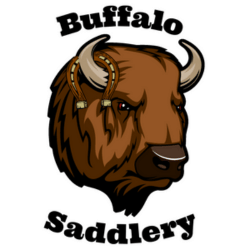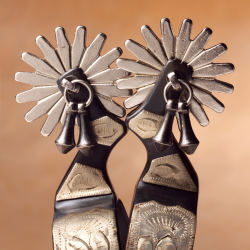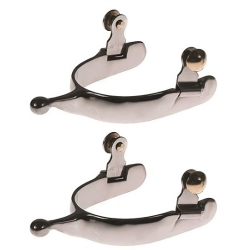Understanding Cowboy Chaps: History, Uses, and Styles
Cowboy chaps have long been associated with the image of cowboys riding the open range, but the history, uses, and styles of these iconic garments are often misunderstood. In this article, we'll delve into the fascinating world of cowboy chaps, exploring their origins and evolution, the various purposes they serve, as well as the different styles available today.
Shop our collection of western leather chinks and chaps
The Historical Evolution of Cowboy Chaps
The story of cowboy chaps begins with the early Spanish influence on the American West. Spanish settlers, known for their horsemanship, introduced the concept of leather leg coverings to protect against brush, thorns, and harsh weather conditions. These early chaps, known as "botas," were made from durable leather and were designed to withstand the rugged terrain of the West.
As the American West began to be settled by pioneers and ranchers, the need for protective clothing became even more crucial. Cowboys and cowgirls spent long hours in the saddle, enduring the elements and facing numerous hazards. It was during this Cowboy Era of the Wild West that chaps truly became synonymous with the rugged image of the American cowboy.
Worn by cowboys as they braved the untamed frontier, chaps provided much-needed protection against the elements. Whether riding through rain, snow, or scorching heat, cowboys relied on their sturdy leather chaps to shield their legs from the harsh outdoor conditions. The thick leather not only protected against thorny brush and branches but also acted as a barrier against the bites of venomous snakes that lurked in the tall grasses.
As the popularity of cowboys grew, so did the demand for chaps. Saddleries and leatherworkers across the West began producing chaps in various styles and designs. Some featured intricate tooling and decorative patterns, showcasing the craftsmanship of the artisans who created them. Others were more utilitarian, focusing solely on functionality.
Fast forward to the present day, and cowboy chaps have evolved beyond their functional roots to become a fashion statement in their own right. While still used for their practical purpose, modern-day chaps come in a variety of styles, materials, and designs, reflecting the diverse needs and tastes of riders. Riders can choose from chaps made of traditional leather, which provides excellent protection and durability, or opt for synthetic materials that offer a lighter and more breathable alternative.
Western fashion has also played a significant role in the evolution of cowboy chaps. Today, riders can find chaps adorned with conchos, fringe, and even intricate beadwork, adding a touch of personal style to their riding attire. Some chaps are designed specifically for rodeo events, featuring reinforced areas to protect against rope burns and abrasions.
Furthermore, advancements in technology have also influenced the design of modern chaps. Manufacturers now incorporate moisture-wicking fabrics into their chaps, keeping riders dry and comfortable during long rides. Additionally, some chaps feature adjustable straps and closures, allowing for a customized fit that ensures maximum comfort and mobility.
As the legacy of the American cowboy continues to captivate the imaginations of people around the world, cowboy chaps remain an iconic symbol of the Wild West. Whether worn for practical purposes or as a fashion statement, these leg coverings continue to embody the spirit of adventure, resilience, and individuality that defines the cowboy way of life.
Understanding the Purpose of Cowboy Chaps
When it comes to the world of cowboys and horse riding, one cannot overlook the importance of cowboy chaps. These iconic pieces of clothing serve a multitude of purposes, going beyond just being a fashion statement. Let's delve deeper into the world of cowboy chaps and explore the various functions they fulfill.
One of the primary functions of cowboy chaps is providing protection against the elements. Made from thick, durable leather, chaps shield riders' legs from thorns, branches, and other hazards encountered on the trail or in the brush. Imagine riding through dense forests or overgrown fields, where every step poses a potential danger. With chaps, cowboys can fearlessly navigate these treacherous terrains, knowing that their legs are well-protected.
Additionally, chaps offer a degree of insulation in colder weather, keeping the legs warm and comfortable during long hours spent outdoors. Picture a cowboy on a frosty morning, riding across vast open plains with the wind biting at their face. The warmth provided by chaps can make a significant difference, ensuring that the rider remains cozy and focused on their tasks.
Beyond weather protection, chaps play a crucial role in ensuring safety in rodeo and ranch work. When participating in high-speed events like barrel racing or bull riding, chaps provide an added layer of protection against potential injuries. They act as a barrier between the rider's legs and the saddle or ground, minimizing the risk of scrapes, cuts, or bruising. In the adrenaline-fueled world of rodeos, where split-second decisions can mean the difference between victory and defeat, chaps offer a sense of security and confidence to the daring cowboys.
Moreover, chaps are an essential component of horse riding. The friction created by the rider's legs against the saddle can cause discomfort and chafing. By wearing chaps, riders not only prevent rubbing but also enjoy increased stability and grip while in the saddle, enhancing their overall riding experience. Imagine galloping across vast prairies, feeling the powerful muscles of the horse beneath you, and having that extra layer of grip provided by chaps. It truly elevates the connection between rider and horse, allowing for seamless communication and control.
So, the next time you see a cowboy donning a pair of chaps, remember that they are not just a fashion statement. They are a practical and essential piece of equipment that serves multiple purposes. From protecting against the elements and preventing injuries to enhancing comfort and improving riding performance, cowboy chaps are a testament to the ingenuity and practicality of the cowboy way of life.
Different Styles of Cowboy Chaps
When it comes to choosing cowboy chaps, riders have a plethora of options to suit their preferences. One classic design is the shotgun chaps. These chaps, originating from the Old West, provide full coverage from the waist down, ensuring maximum protection for the rider's legs. With their straight-cut design and adjustable straps, shotgun chaps are a timeless choice for both working cowboys and rodeo performers.
Shotgun chaps have a rich history that dates back to the 1800s. They were originally designed to protect cowboys from thorny bushes, harsh weather conditions, and potential injuries while riding through rugged terrain. The durable leather material used in their construction makes them suitable for various activities, such as cattle herding, roping, and trail riding.
For those seeking greater freedom of movement, batwing chaps are an excellent choice. With their flared shape, batwing chaps offer flexibility and allow for a wider range of motion during high-intensity rodeo events or ranch work. These chaps combine functionality with style, making them a popular option among modern riders.
Originally, batwing chaps were favored by cowboys who needed to quickly mount and dismount their horses while working on the range. The flared design allowed for easy movement and prevented the chaps from getting caught on stirrups or other obstacles. Today, batwing chaps have evolved to become a fashion statement, with riders customizing them with intricate designs, tooling, and decorative conchos.
Another style to consider is chinks, which are shorter chaps that end above the knee. Chinks offer excellent protection for the upper legs while providing increased ventilation and freedom for the lower legs. Ideal for warmer weather or riders who prefer a less restrictive feel, chinks strike a balance between practicality and comfort.
Chinks have a long history in the cowboy culture, particularly in the Southwest. They were initially worn by vaqueros, skilled horsemen who herded cattle in the Spanish colonies of the Americas. The shorter length of chinks allowed vaqueros to move more freely while still providing some protection from brush, cacti, and other hazards of the range.
Finally, woolies are the go-to choice for winter riding. Made from a combination of leather and sheepskin, these chaps provide both insulation and coziness during chilly months. Woolies are highly sought after by riders who value warmth and comfort without compromising on style.
Woolies have a unique charm that harkens back to the frontier days. Cowboys and ranchers in colder regions relied on woolies to keep them warm during long rides in freezing temperatures. The sheepskin lining not only provided insulation but also added a touch of luxury to the chaps. Today, woolies are still cherished by riders who want to stay comfortable and stylish while braving the winter elements.
How to Choose and Wear Cowboy Chaps
When it comes to selecting cowboy chaps, there are a few key factors to consider. Proper sizing and fitting are essential for both comfort and functionality. Chaps should fit snugly but comfortably, allowing for easy movement without restricting mobility. To ensure you find the right size, it's crucial to measure your inseam, waist, and thigh circumference accurately.
Additionally, adjustable straps or buckles on chaps can greatly aid in achieving a customized fit for different body types. These adjustable features allow you to tighten or loosen the chaps as needed, providing a comfortable and secure fit. Whether you have long legs or a more muscular build, adjustable straps ensure that you can find the perfect fit for your body.
Once you have found the perfect pair of cowboy chaps, it's important to properly maintain and clean them. Regular care will not only help extend the lifespan of your chaps but also keep them looking their best. One of the simplest ways to care for your chaps is by regularly brushing off any dirt or dust. This simple step helps prevent dirt from settling into the leather and causing damage over time.
In addition to brushing, wiping down your chaps with a damp cloth can help remove any stubborn stains or dirt. Be sure to use a clean cloth and gentle, non-abrasive cleaning solutions to avoid damaging the leather. After cleaning, applying a high-quality leather conditioner is essential to keep the chaps supple and prevent cracking or drying out.
It's also important to follow the manufacturer's care instructions for your specific chaps. These instructions may include recommendations on how to store your chaps when not in use, as well as tips on avoiding excessive exposure to sunlight or water. By following these guidelines, you can ensure that your chaps remain in top condition for years to come.
Ultimately, understanding the history, uses, and styles of cowboy chaps allows riders to make informed decisions when choosing these essential garments. Cowboy chaps have a rich heritage deeply rooted in the Western lifestyle. They were originally designed to provide protection while working on horseback, shielding riders' legs from brush, thorns, and other hazards.
Today, cowboy chaps are not only functional but also a symbol of tradition and rugged style. They are worn by working cowboys, rodeo enthusiasts, and those who simply admire the Western way of life. With various styles available, from classic fringed chaps to modern designs, there is a pair of cowboy chaps to suit every individual's taste.
So, whether you're a seasoned cowboy or just starting to embrace the Western aesthetic, cowboy chaps are a versatile and essential piece of clothing. They not only offer protection and functionality but also add a touch of timeless style to any outfit. So saddle up, put on your chaps, and embrace the spirit of the Wild West!














































